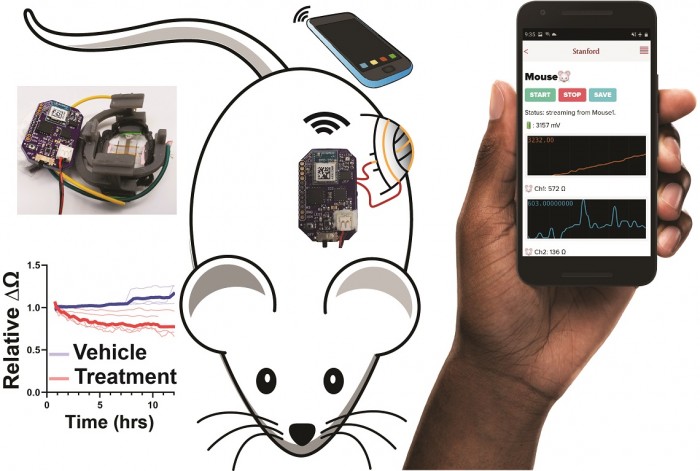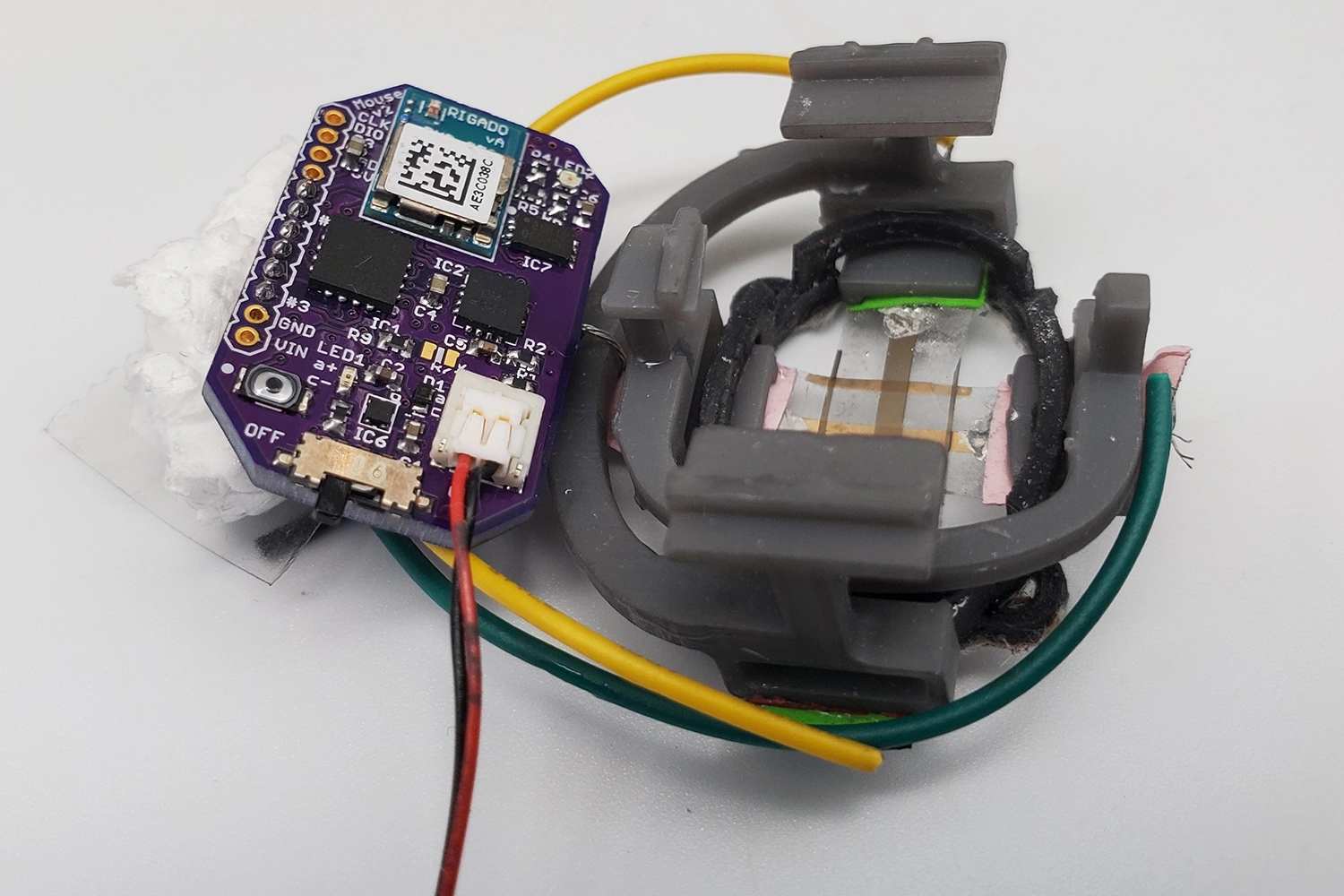Engineers at Stanford University and Georgia Institute of Technology have created a small, autonomous device with a stretchable, flexible sensor that attaches to the skin and measures changes in the size of underlying tumors. The battery-powered, non-invasive device has a signal sensitivity of 10 microns and can wirelessly transmit the results in real time to a smartphone app at the push of a button.

The researchers said that this "Flexible Autonomous Sensor for Measuring Tumors" (FAST) represents a new, fast, cheap, portable and accurate method to test the efficacy of anti-cancer drugs. In the long run, it may point out new directions for cancer treatment. The FAST sensor can detect changes in tumor volume on a minute scale, while caliper and bioluminescence measurements usually require weeks of observation to measure changes in tumor size.

FAST consists of a flexible and stretchable skin-like polymer that includes a layer of embedded gold circuitry. The sensor is attached to a small electronic backpack. The device measures the tension (degree of stretch or contraction) on the film and transmits the data to a smartphone. Using the FAST backpack, potential therapeutic efficacy associated with tumor size regression can be quickly and accurately determined or fast-tracked for further study.
The researchers say the new device offers at least three significant advances. First, it provides continuous monitoring because the sensors are physically connected to the mouse and remain in place throughout the experiment. Second, the flexible sensors wrap around the tumor, making it possible to measure shape changes that would be difficult to discern with other methods. Third, FAST is both autonomous and non-invasive. It attaches to the skin like a Band-Aid, is battery-operated, and wirelessly connected. The mouse can move freely without being hindered by the device or wires, and scientists do not need to actively operate the mouse after placing the sensors. The FAST backpack is also reusable, costs only about $60 to assemble, and can be connected to the mouse in a few minutes.
“It’s a deceptively simple design,” said Alex Abramson, lead author of the study, a postdoctoral fellow in Zhenan Bao’s lab at Stanford’s School of Engineering and now an assistant professor at Georgia Tech. “But the pharmaceutical and oncology communities should be very interested in the advantages. FAST is automated, which could greatly speed up and reduce the cost of the cancer therapy screening process.”
Previous article:Sony is developing the first over-the-counter hearing aid
Next article:Yike Bio Group acquires Shanghai Tarisa Healthcare
- High-speed 3D bioprinter is available, using sound waves to accurately build cell structures in seconds
- [“Source” Observation Series] Application of Keithley in Particle Beam Detection Based on Perovskite System
- STMicroelectronics’ Biosensing Innovation Enables Next-Generation Wearable Personal Healthcare and Fitness Devices
- China's first national standard for organ chips is officially released, led by the Medical Devices Institute of Southeast University
- The world's first non-electric touchpad is launched: it can sense contact force, area and position even without electricity
- Artificial intelligence designs thousands of new DNA switches to precisely control gene expression
- Mouser Electronics provides electronic design engineers with advanced medical technology resources and products
- Qualcomm Wireless Care provides mobile terminal devices to empower grassroots medical workers with technology
- Magnetoelectric nanodiscs stimulate deep brain noninvasively
- Innolux's intelligent steer-by-wire solution makes cars smarter and safer
- 8051 MCU - Parity Check
- How to efficiently balance the sensitivity of tactile sensing interfaces
- What should I do if the servo motor shakes? What causes the servo motor to shake quickly?
- 【Brushless Motor】Analysis of three-phase BLDC motor and sharing of two popular development boards
- Midea Industrial Technology's subsidiaries Clou Electronics and Hekang New Energy jointly appeared at the Munich Battery Energy Storage Exhibition and Solar Energy Exhibition
- Guoxin Sichen | Application of ferroelectric memory PB85RS2MC in power battery management, with a capacity of 2M
- Analysis of common faults of frequency converter
- In a head-on competition with Qualcomm, what kind of cockpit products has Intel come up with?
- Dalian Rongke's all-vanadium liquid flow battery energy storage equipment industrialization project has entered the sprint stage before production
- Allegro MicroSystems Introduces Advanced Magnetic and Inductive Position Sensing Solutions at Electronica 2024
- Car key in the left hand, liveness detection radar in the right hand, UWB is imperative for cars!
- After a decade of rapid development, domestic CIS has entered the market
- Aegis Dagger Battery + Thor EM-i Super Hybrid, Geely New Energy has thrown out two "king bombs"
- A brief discussion on functional safety - fault, error, and failure
- In the smart car 2.0 cycle, these core industry chains are facing major opportunities!
- The United States and Japan are developing new batteries. CATL faces challenges? How should China's new energy battery industry respond?
- Murata launches high-precision 6-axis inertial sensor for automobiles
- Ford patents pre-charge alarm to help save costs and respond to emergencies
- New real-time microcontroller system from Texas Instruments enables smarter processing in automotive and industrial applications
- Exchange for E coins!!!
- The era of distributed edge computing is coming? What do you think about this?
- 5G commonly used terms, too comprehensive.
- [Teardown] What is the resolution of 20 million pixels? Do you really understand digital microscopes?
- LPS27HHTW MEMS Pressure Sensor
- Are lead-free HASL and lead-free solder the same thing?
- CC2640R2F ADC
- Summary of the use of polarity and phase of MSP430 SPI
- How Designers Achieve Tri-Band Gigabit Speeds and High Throughput in Wi-Fi
- TMS320VC5502+ISP1581 USB2.0 high-speed data acquisition solution

 Implantable Sensors and Systems:From Theory to Practice
Implantable Sensors and Systems:From Theory to Practice MAX78615 + LMU, pdf data sheet
MAX78615 + LMU, pdf data sheet Basic knowledge of mobile phone camera module.ppt
Basic knowledge of mobile phone camera module.ppt
















 京公网安备 11010802033920号
京公网安备 11010802033920号